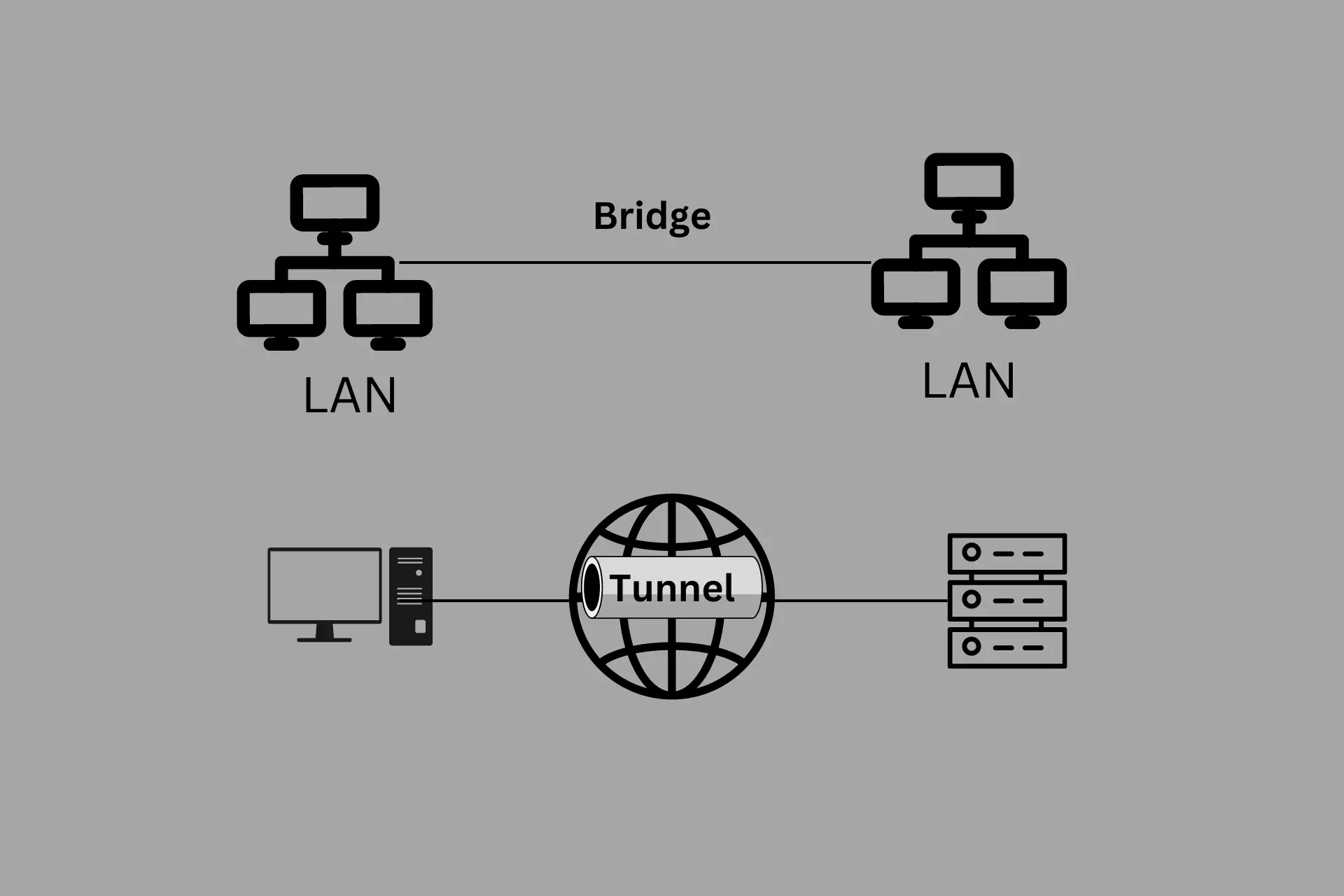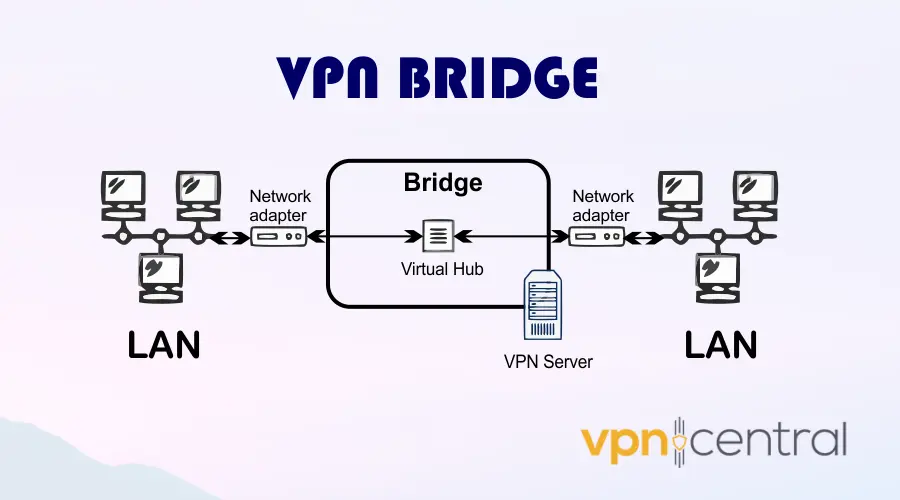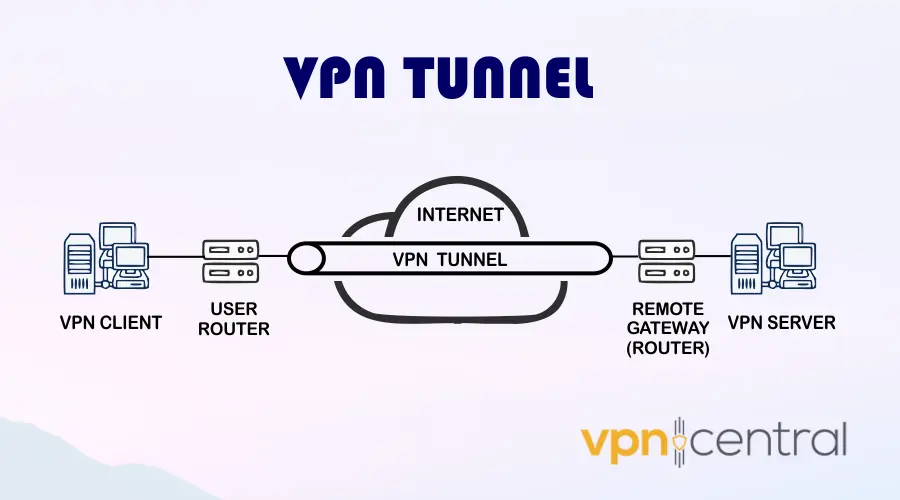VPN Bridge vs Tunnel: Understanding the Differences
5 min. read
Updated on
Read our disclosure page to find out how can you help VPNCentral sustain the editorial team Read more

Virtual Private Network- or VPN is a term that’s actually attached to multiple types of connections.
The most common ones are the VPN bridge and the VPN tunnel. But what exactly do these terms mean, and how do they differ?
They’re actually very different and serve different purposes. Read on to learn how both of them work, key differences and use cases.
VPN bridge vs tunnel – What’s the difference?
VPN bridges and tunnels are different types of connnections. One works without the other, as they’re not elements of the same type of configuration.
Simply put VPN bridges connect two LANs to create a more extensive network and making file sharing easier and safer.
VPN tunnels securely encapsulate network traffic and transmit it over the public Internet.
But before delving deep into each of them, let’s break down the differences in a simple way.
| VPN Bridge | VPN Tunnel |
| Connects directly to the network, creating a direct link between two LANs (Local Area Networks) | Connects to a network through an encrypted connection, routing all network traffic through the encrypted tunnel |
| Acts as a gateway for forwarding data between the two LANs. | Acts as a secure shield between a device and the Internet. |
| Allows devices on both LANs to communicate as if they were on the same network | Generally considered more secure, as all data transmitted through the tunnel is encrypted |
| Offers a faster connection but less security, as the traffic is not encrypted | Offers slower connection speeds, as the data must be encrypted and decrypted before being transmitted |
| Works on the data link layer (layer 2) of the OSI model | Works on the network layer (layer 3) of the OSI model |
Let’s break it down.
VPN bridge

Combining two separate Ethernet networks into one logical subnet is possible by creating a bridge between a physical Ethernet NIC and an OpenVPN-driven TAP interface at two different locations.
A VPN bridge is software or hardware that allows these two LANs to be connected over the Internet.
This connection is established using Internet Protocol (IP) and it allows the two LANs to communicate as if they were on the same network.
Also, VPN bridges can operate in different modes, most commonly transparent or routing modes:
→ Transparent mode connects two LANs without configuring any IP addresses on the bridge.
→ Routing mode, on the other hand, requires IP addresses to be configured and allows the two LANs to communicate using IP routing.
VPN tunnel

A VPN tunnel encrypts internet traffic between a client and a server. The encryption works by converting plain text into an unreadable ciphertext using a cryptographic key.
Some popular encryption algorithms include Advanced Encryption Standard (AES) and RSA (Rivest–Shamir–Adleman).
Secured by any of these algorithms, the client establishes a connection to the VPN server, which acts as a gateway to the Internet.
All traffic sent between the provider and the server is encrypted and protected from being intercepted by malicious actors.
VPN tunnels can be established using different protocols, such as PPTP, L2TP, or OpenVPN.
Use cases
The choice between a VPN bridge vs a tunnel depends on the use case.
Here is the breakdown of how and when they can be helpful.
When do you use VPN bridge?
VPN bridges are often used in industrial settings where secure, real-time data transfer is required between two LANs.
Many companies use this model to enable better data-sharing security for remote workers or when they have several different office locations.
They help interconnect two different LANs to share resources and information faster and easier.
Since VPN bridges help to connect two LANs directly in remote locations, it allows devices on both LANs to communicate as if they were on the same network.
Ultimately, it leads to a fast connection.
However, the traffic is not encrypted. That means the connection is less secure than a VPN tunnel, but it is still helpful in specific scenarios where a direct, fast connection is required.
When do you use a VPN tunnel?
They are ideal for protecting sensitive data transmissions, such as financial transactions or confidential information.
Also, you can use them to bypass censorship and access websites blocked in a particular region, as long as your VPN provider offers remote servers in locations where it’s not blocked.
The VPN tunnel provides a secure connection, as all traffic is encrypted before transmission.
This makes VPN tunnels ideal for security concerns, such as when transmitting sensitive data or when remote access to a network is required.
Additionally, it offers secure communication between two LANs over the Internet, mainly when a direct connection is impossible.
This is typically what commercial VPNs are. They market themselves as security software that can hide your data from your ISP, help bypass geo-blocks, and more.
However, the main drawback of VPN tunnels is that the connection can be slower, as the data must be encrypted and decrypted before being transmitted.
VPN providers do however work hard to upgrade their servers for better speed.
Conclusion
VPN bridges and tunnels are two distinct methods of establishing a VPN connection.
While VPN bridges connect two LANs, VPN tunnels encrypt internet traffic before connection, making browsing on public Internet safer.
VPN bridges are ideal for a direct, fast connection when you want to share data between two LANs.
In contrast, VPN tunnels are best forprotecting sensitive data transmission over the Internet.









User forum
0 messages